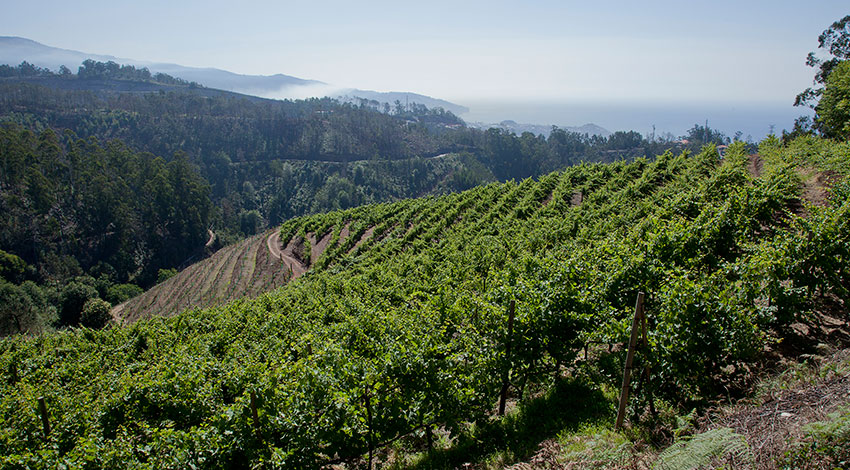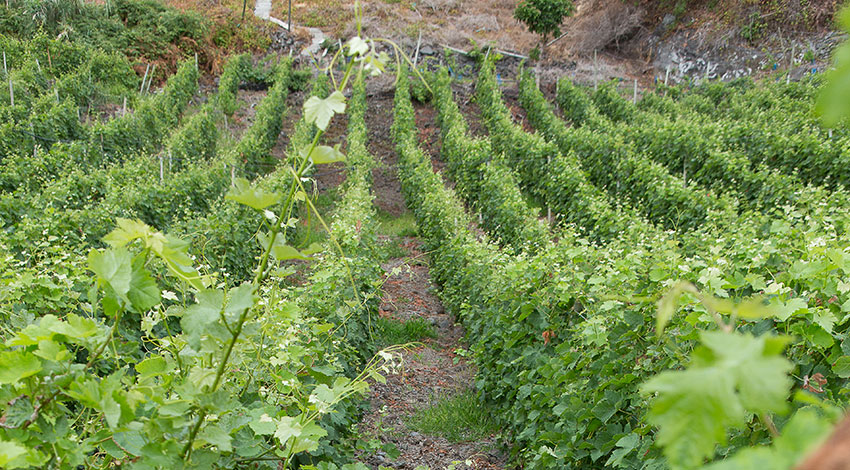Vineyards, wine tastings, cellars and plenty of history are the ingredients of a tour around the wine routes in Madeira.
Situated in a historic building, dating back to 1619 and the main entrance for students of the former Jesuit College in Funchal, the Pereira D’Oliveiras wine cellars are a place to visit and taste wine. The company incorporates five Madeira Wine producers and was founded in 1820.
Nearby, the wine cellars of H.M.Borges, a company founded in 1877, are also open to visitors and wine lovers.
It’s difficult to talk about the history of Madeira and not mention its wine, as both will be forever connected. Proof of that are the wine cellars of the Madeira Wine Company, a perfect example between the historic component, wine tasting sessions and bottles for purchase. Located in a building dating back to 1473, it was a convent devoted to Saint Francis which has suffered many alterations throughout the centuries but still maintains an attractive architecture. Ana Soares, public relations of the company, speaks of the wine tasting sessions which are carried out in the wine cellars and combines Madeira Wine with different appetizers: “Sercial with cheese, Verdelho with almonds, Bual with honey cake and Malvasia with chocolate”, all are perfect combinations which make your mouth water.
Here, in addition to the tasting sessions and a historic-filled tour that can be enjoyed in three different ways, there is also one of the best museums on the island dedicated to the wine theme.
We move on to Câmara de Lobos, the main vineyard area in Madeira, where the historic link between wine and the island is still long lasting. Those who pass the civic centre of Estreito de Câmara de Lobos cannot turn a blind eye to the extension of vineyards, almost as old as human presence on the island, which belonged to the family of João Gonçalves Zarco, first Captain Donatory.
On the cliffs of Câmara de Lobos, vineyards can be seen a little everywhere, from the sea level straight up to the hotel Quinta da Serra located in Jardim da Serra where the highest plantations of Sercial can be found.
A must-see visit includes a tour of Henriques & Henriques. The main vineyard, located at Quinta Grande, “is one of the oldest contiguous spots on the island that is dedicated exclusively to the cultivation of grapes which are suitable for the production of Madeira Wine” says Maria da Luz Aguiar, one of those in charge at the company. Providing prior reservation, it’s possible to visit the wine production cellars and the vineyards with the choice of also including a meal and a tasting session.
On route to Cabo Girão, the highest headland in Europe, there is another stop off point at the Barbeito Wine Cellars where one can get an overall insight into the whole grape treatment process right from the fermentation stage up to the final product. Professional tasting sessions are available.
Leaving Câmara de Lobos and following along the old road, we arrive at Fajã dos Padres. Here the Jesuit priests, owners of the land until 1759, produced some of the best Malvasias known to date. The vineyards are still used for production.
On the way to Ponta do Sol, small vineyards of the Bual grape variety are difficult to miss. But further west, in Prazeres, we can find Quinta das Vinhas a house dating back to the XIX century used for tourism purposes. Here we come into contact with “all the different grape varieties used to produce Madeira Wine” explains wine specialist Américo Pereira. A quiet spot, with all the grape varieties properly identified and ideal for those who do not need a guide. Entrance is free of charge.
But Madeira isn’t all about fortified wine. The island is increasingly paving its way in the table wine market. The history behind table wine production is more of a recent one which dates back the last three decades.
On the north coast, in Seixal, it’s important to mention the work of Duarte Caldeira and sons who produce red and white table wines. As an agronomist he is one of the great mentors of this project which is increasingly captivating a wider audience. In groups of 10 people, minimum, here you can appreciate the beautiful landscape and vineyards of Seixal, wine tasting sessions and a quiet lunch served in a 200 year old house where you can enjoy the best of “grandma’s food and grandpa’s wine”, Duarte Caldeira says playfully. Commercially known as Terras do Avó (Grandpa’s Lands), they represent four different wines: two red and two white.
Still on the north of the island, we come across the wine cellars of São Vicente and Quinta do Barbusano where, according to Américo Pereira, there is one of the “best vineyard trellises” of Madeira.
The journey continues down to Arco de São Jorge to the Wine and Vineyard Museum. Here you can go on a tour around an old wine cellar and follow the different cycles of the vineyard including clarifications on the different grape varieties and their characteristics.
In Santana at Quinta do Furão, you can lose yourself in the flavours of a wine dinner served, once a week, amongst the vineyards of the hotel.
Further on we arrive at Caniçal where you can visit the vineyards of three different companies: Pedra de Fogo e Beijo, located near to the Whale Museum, and Primeira Paixão.
On the way back to Funchal it’s worth stopping off at Justino’s, one of the most awarded wine producers on the island. Tours are subject to prior reservation.
Madeira doesn’t have an official wine route per se but it isn’t short of options for wine lovers. The island has a total of 496 acres of vineyards. In Alentejo one property alone has 600 acres which only comes to prove that quality isn’t measured by quantity.
However, that doesn’t prevent the island from being well known for its liqueur wines, rich in history, which date back almost six centuries.



















